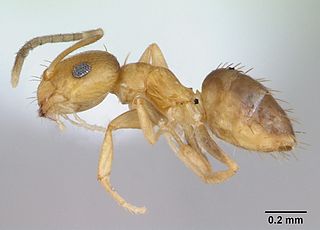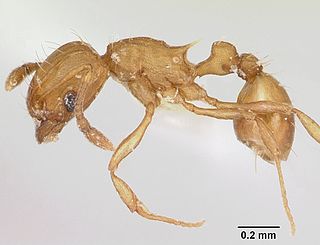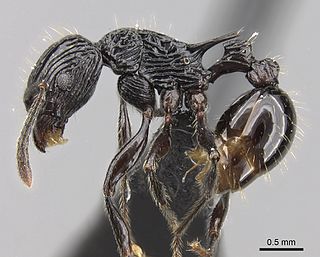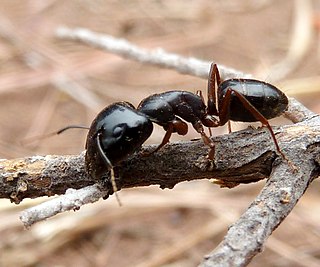
The yellow crazy ant, also known as the long-legged ant or Maldive ant, is a species of ant, thought to be native to West Africa or Asia. They have been accidentally introduced to numerous places in the world's tropics.

Invasive species in Australia are a serious threat to the native biodiversity, and an ongoing cost to Australian agriculture. Numerous species arrived with European maritime exploration and colonisation of Australia and steadily since then.

Myrmicinae is a subfamily of ants, with about 140 extant genera; their distribution is cosmopolitan. The pupae lack cocoons. Some species retain a functional sting. The petioles of Myrmicinae consist of two nodes. The nests are permanent and in soil, rotting wood, under stones, or in trees.

Tapinoma melanocephalum is a species of ant that goes by the common name ghost ant. They are recognised by their dark head and pale or translucent legs and gaster (abdomen). This colouring makes this tiny ant seem even smaller.

Tetramorium immigrans—also known as the immigrant pavement ant, pavement ant, and the sugar ant in parts of North America—is an ant native to Europe, which also occurs as an introduced pest in North America. Its common name comes from the fact that colonies in North America usually make their nests under pavement. This is one of the most commonly seen ants in North America, being well adapted to urban and suburban habitats. It is distinguished by one pair of spines on the back, two nodes on the petiole, and grooves on the head and thorax.

Tetramorium inquilinum is an ectoparasitic ant found in Europe. It was discovered by Swiss myrmecologist Heinrich Kutter. The species is unusual for lacking a worker caste, the queens and males living entirely off the care of the pavement ant. It has been called "the 'ultimate' parasitic ant" by myrmecologists Edward O. Wilson and Bert Hölldobler.

Tetramorium is a genus of ants in the subfamily Myrmicinae that includes more than 520 species. These ants are also known as pavement ants.

Brachymyrmex is a genus in the ants subfamily Formicinae. The genus can be recognized by the combination of having nine antennal segments and the petiole concealed by the gaster in dorsal view. They are sometimes called "rover ants".

The little fire ant, also known as the electric ant, is a small, light to golden brown (ginger) social ant native to Central and South America, now spread to parts of Africa, Taiwan, North America, Puerto Rico, Israel, Cuba, and six Pacific Island groups plus north-eastern Australia (Cairns). It is a very harmful invasive species.

Ochetellus glaber is a species of ant native to Australia. A member of the genus Ochetellus in the subfamily Dolichoderinae, it was described by Austrian entomologist Gustav Mayr in 1862. Aside from Australia, O. glaber has been introduced to a number of countries, including China, India, Japan, New Zealand, the Philippines and the United States, where it has established itself in Hawaii and Florida. It has been found on Lord Howe Island, New Caledonia, Norfolk Island, Réunion and the Solomon Islands. Compared with other ants, O. glaber is a small species, with workers measuring 2–3 mm (0.079–0.118 in). Males are the smallest at 1.6 mm (0.063 in), while the queens measure 5.2–5.5 mm (0.20–0.22 in). The ant's colour ranges from brown to black.

The red imported fire ant, or simply RIFA, is one of over 280 species in the widespread genus Solenopsis. It is native to South America but it has become both a pest and a health hazard in the southern United States as well as a number of other countries.

Zigrasimecia is an extinct genus of ants which existed in the Cretaceous period approximately 98 million years ago. The first specimens were collected from Burmese amber in Kachin State, 100 kilometres (62 mi) west of Myitkyina town in Myanmar. In 2013, palaeoentomologists Phillip Barden and David Grimaldi published a paper describing and naming Zigrasimecia tonsora. They described a dealate female with unusual features, notably the highly specialized mandibles. Other features include large ocelli, short scapes, 12 antennomeres, small eyes, and a clypeal margin that has a row of peg-like denticles. The genus Zigrasimecia was originally incertae sedis within Formicidae until a second species, Zigrasimecia ferox, was described in 2014, leading to its placement in the subfamily Sphecomyrminae. Later, it was considered to belong to the distinct subfamily Zigrasimeciinae.

Trichomyrmex destructor is a species of ant in the subfamily Myrmicinae. Its common names include destructive trailing ant or Singapore ant. It is a pest species in urban areas, known for causing costly damage to structures, vehicles, and electronic devices with its chewing activity. In 2015, the species was moved from the genus Monomorium to the revised genus Trichomyrmex.

Tetramorium nazgul is a species of Myrmicine ant native to Analalava, Ambohijanahary, and the Zombitse-Vohibasia National Park, Madagascar. The species is characterized by long, thin, propodeal spines. Its body is covered in a multitude of long hairs. General coloration is dark brown or black, with lighter coloration on the legs. The species is commonly found in leaf litter in tropical dry forests and montane rainforests, typically around elevations of 700 to 1,100 meters. It was named after the Nazgûl from J. R. R. Tolkien's The Lord of the Rings.

Tetramorium smaug is a species of myrmicine ant native to Ambatovy, Amber Mountain National Park, and Ivohibe in Madagascar. It was found in montane rainforests around elevations of 900–1,300 metres (3,000–4,300 ft). It is believed to live in vegetation as opposed to on the forest floor. Coloration is dark brown or black. The head and mesosoma have rough surfaces while the gaster is smooth. The head has a large number of hairs, but the amount of hair decreases on each segment posteriorly. The species has long propodeal spines with a broad base. It was named after the dragon Smaug from J. R. R. Tolkien's novel The Hobbit.

Camponotus empedocles is a large and dark species of carpenter ant with an extensive range in the Afrotropics.

Plagiolepis alluaudi, the little yellow ant, is a species of Plagiolepis. The species is native to Madagascar, an island off the coast of East Africa. It is known to be a widespread invasive species. In an effort to distinguish its name from other small and yellow species of ant it may be called Alluaud's little yellow ant, after Charles A. Alluaud.

Tetramorium hispidum is a species of ant in the subfamily Myrmicinae. Tetramorium hispidum differs from similar ants in the Myrmicinae subfamily by the structure surrounding the ant's antennal insertions. Short, stubble-like hairs exist on the pronotum and frontal carinae. The antenna of Tetramorium hispidum contains 11 segments.
Paracletus cimiciformis is a species of aphid with a complex life cycle. Its primary host plant is Pistacia and its secondary host is a grass, where it is present on the roots. Here it is associated with an ant and part of its life cycle is spent in the ant's nest.
In ecology, a tramp species is an organism that has been spread globally by human activities. The term was coined by William Morton Wheeler in the bulletin of the American museum of natural history in 1906, used to describe ants that “have made their way as well known tramps or stow-aways[sic] to many islands The term has since widened to include non-ant organisms, but remains most popular in myrmecology. Tramp species have been noted in multiple phyla spanning both animal and plant kingdoms, including but not limited to arthropods, mollusca, bryophytes, and pteridophytes. The term "tramp species" was popularized and given a more set definition by Luc Passera in his chapter of David F William's 1994 book Exotic Ants: Biology, Impact, And Control Of Introduced Species.

















